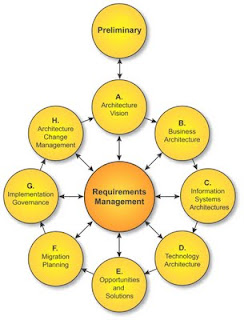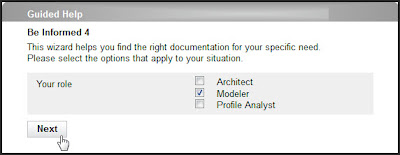An Open Framework for Technical Communicators?
 In the previous post I mentioned that creating user-oriented documentation requires an understanding of the audience and its tasks and processes. The trick has always been that it is hard to explain the days or weeks spend on audience and task analysis, while it doesn't deliver a visible contribution to our work from the start. There also isn't a real method or framework - that we can refer to - that demands the activities and deliverables that come with an audience and task analysis.
In the previous post I mentioned that creating user-oriented documentation requires an understanding of the audience and its tasks and processes. The trick has always been that it is hard to explain the days or weeks spend on audience and task analysis, while it doesn't deliver a visible contribution to our work from the start. There also isn't a real method or framework - that we can refer to - that demands the activities and deliverables that come with an audience and task analysis.In this area we can learn from ICT Architects, especially when it comes to:
- Usage of a common and widely accepted framework like DYA or TOGAF
- Development of standard notation methods, like Archimate for creating models of the different architectural layers of a solution
- Visibility of all activities and models in the end result.
 A fact is that there are standards for documentation, but they are more or less focused on the quality of the end product and not on the process of creating it. In the same way as the Open Group has created a framework for Enterprise Architure, a community of technical communicators - supported by for instance the Society for Technical Communication (STC) or the Institute for Scientific and Technical Communicators (ISTC) - should stand up and define a set of tools, templates and methods for technical communicators, presented as an open framework.
A fact is that there are standards for documentation, but they are more or less focused on the quality of the end product and not on the process of creating it. In the same way as the Open Group has created a framework for Enterprise Architure, a community of technical communicators - supported by for instance the Society for Technical Communication (STC) or the Institute for Scientific and Technical Communicators (ISTC) - should stand up and define a set of tools, templates and methods for technical communicators, presented as an open framework.There is absolutely nothing wrong with the current education programs and standards, but what we need is something that bundles all efforts and transforms it into an industry standard. And in my opinion this standard should focus solely on the process of documentation creation instead of on the end product of it.
How do we benefit from such a framework?
Do you get tired of explaining over and over again why you need that audience analysis or why you want to pretest your documentation? Well, as an ICT Architect I only have to say that I have to comply to the TOGAF standards and all discussion about needed analysis and modelling time is gone. So having our framework for technical communication would not only give us a good reference on how to do thing, it will also make it easier to explain why we need activities like audience analysis and pretesting. Not complying to the framework is still a choice, but it will be an explicit one.
What do we need to create such a framework?
Well in fact most of us probably have an idea what should be in it. We have a lot of knowledge, best practices and research data available at for instance the STC and the ISTC. In my opinion the focus should be on bundling and prioritizing the information that we already have, to produce a version 0.1 of our very own Technical Writing Framework. By making use of the international community of technical writers and the possibilities of communities on the internet, we can evolve this method to the technical communicator's equivalent of TOGAF.
How do we give it the status of a real framework for technical communicators?
Well I know it might sound too easy, but in my experience something "new" becomes "common" just by accepting it as the standard and start communicating about it in this way. And yes, we need a website, we need a name for the framework and we need people to spread the news and share their experiences.
I hope this is enough food for thought for now. Don't hesitate to drop your opinion in the comment box or start a discussion.
Next time I will continue my exploration of lessons learned as an ICT Architect. First I will look at the similarities between TOGAF and the process of writing technical documentation and come up with the raw outline of a framework for technical writers. Next I will talk about using modelling techniques - similar to Archimate - that technical communicators could benefit from in the earlier stages of their writing project.


Comments